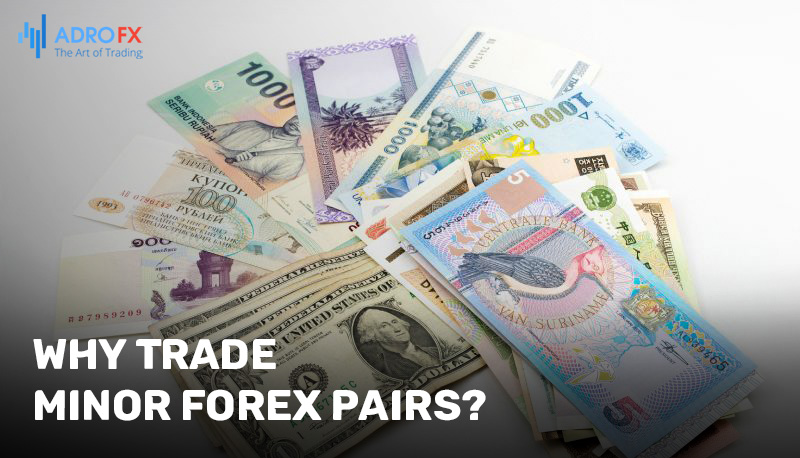Exploring the Advantages of Trading Minor Forex Pairs: Volatility, Diversification, and Lower Correlation

In the vast and dynamic world of forex trading, minor currency pairs often hold untapped potential for traders. While major currency pairs dominate the forex market, it's crucial not to overlook the opportunities presented by minor forex pairs. These pairs involve currencies from smaller economies or emerging markets paired with major currencies. Trading minor forex pairs can provide traders with higher volatility, the opportunity to diversify their portfolios, and a lower correlation with major pairs. In this article, we will explore the reasons why trading minor forex pairs can be advantageous and delve into strategies and tips for effectively navigating the world of minor currency trading.
What Are Minor Currency Pairs?
Cross currency pairs, also known as minor forex pairs, are combinations of currencies involving smaller economies or emerging markets, alongside major currencies like the US dollar, euro, or Japanese yen. These pairs are actively traded in the foreign exchange market (forex).
In forex trading, major currency pairs comprise the most frequently traded currencies, such as EUR/USD (euro/US dollar), GBP/USD (British pound/US dollar), and USD/JPY (US dollar/Japanese yen). Conversely, minor forex pairs involve currencies from countries with smaller economies or lower market liquidity.

Several examples of minor forex pairs include:
- USD/SGD (US dollar/Singapore dollar): Combining the US dollar and the Singapore dollar.
- USD/ZAR (US dollar/South African rand): Combining the US dollar and the South African rand.
- EUR/AUD (euro/Australian dollar): Combining the euro and the Australian dollar.
- GBP/CAD (British pound/Canadian dollar): Combining the British pound and the Canadian dollar.
- JPY/NOK (Japanese yen/Norwegian krone): Combining the Japanese yen and the Norwegian krone.
Compared to major pairs, minor forex pairs typically exhibit wider spreads and lower liquidity. They may also experience higher volatility and increased risk due to country-specific economic and political factors. Traders who engage in minor forex pair trading often aim to capitalize on potential price fluctuations and market inefficiencies.
What Moves Minor Currencies?
Several factors can move minor currencies, influencing their exchange rates. Here are some key factors that can impact minor currencies:
- Economic Indicators: Economic data releases play a significant role in moving minor currencies. Indicators such as GDP growth, inflation rates, employment data, trade balance, and interest rate decisions can influence investor sentiment and market expectations, thereby affecting the value of the minor currency.
- Interest Rates: Changes in interest rates set by central banks can impact minor currencies. Higher interest rates attract foreign investments, increasing demand for the currency and potentially strengthening its value. Conversely, lower interest rates can lead to capital outflows and currency depreciation.
- Political Stability and Geopolitical Events: Political stability or instability can greatly impact a minor currency. Elections, government policies, geopolitical tensions, and social unrest can create uncertainty, influencing investor confidence and the demand for the currency.
- Commodity Prices: For countries that are significant exporters or importers of commodities, changes in commodity prices, such as oil, gold, or agricultural products, can affect the value of their currencies. For example, a country heavily dependent on oil exports may experience currency fluctuations when oil prices rise or fall.
- Market Sentiment and Risk Appetite: Investor sentiment and risk appetite can influence minor currencies. During periods of risk aversion, investors tend to seek safer assets, which may result in a sell-off of higher-risk minor currencies, leading to depreciation. Conversely, improved market sentiment can drive up demand for riskier assets, potentially strengthening minor currencies.
- Speculation and Market Forces: Speculative trading activities, including large-scale currency trades or carry trades, can impact minor currencies. Market participants' expectations, sentiment, and market positioning can influence short-term fluctuations in exchange rates.
- Intervention by Central Banks: Central banks may intervene in the currency markets to influence their domestic currency's value. Intervention can involve buying or selling the currency to stabilize its exchange rate or achieve specific policy objectives, such as boosting export competitiveness.
- Cross-Currency Relationships: Minor currencies can also be influenced by their relationships with major currencies. Changes in major currency pairs can indirectly impact minor currencies due to their correlation or perceived risk-on/risk-off dynamics.
It's important to note that the specific factors influencing minor currencies can vary depending on the country and its economic characteristics. Traders and investors should stay informed about economic developments, monitor relevant indicators, and assess the interplay of these factors to understand the potential drivers of minor currency movements.

The Volatility of Minor Currency Pairs
Volatility in minor currency pairs is generally higher compared to major currency pairs. This increased volatility can be attributed to several factors, including the following:
- Lower Liquidity: Minor currency pairs tend to have lower trading volumes and liquidity than major pairs. This lower liquidity can result in wider spreads and larger price movements when trades are executed, leading to increased volatility.
- Economic Factors: Minor currency pairs involve currencies from economies that may be more susceptible to economic fluctuations, political instability, or market shocks. Economic events such as changes in interest rates, GDP reports, employment data, or political developments can significantly impact the value of minor currency pairs, contributing to increased volatility.
- Market Sentiment: Minor currency pairs can be influenced by market sentiment and risk appetite. Traders may perceive these pairs as riskier due to the aforementioned factors, leading to more significant price swings during periods of market uncertainty or heightened risk aversion.
- News and Geopolitical Events: News releases and geopolitical events specific to the countries involved in minor currency pairs can have a substantial impact on their exchange rates. Unexpected political developments, natural disasters, or changes in government policies can cause rapid and significant price movements, contributing to higher volatility.
It is important to note that while higher volatility can present profit opportunities, it also carries higher risks. Traders should exercise caution, employ proper risk management techniques, and conduct thorough analysis before trading minor currency pairs. Additionally, staying updated on economic and political developments and using appropriate trading strategies can help navigate the higher volatility associated with these pairs.
How to Trade Minor Currency Pairs?
When trading minor forex pairs, it's important to keep in mind that these pairs can exhibit higher volatility and lower liquidity compared to major currency pairs. Here are some strategies and tips to consider when trading minor forex pairs:
Research and Stay Informed
Stay updated on the economic and political factors affecting the countries involved in the minor forex pairs you are trading. Monitor news releases, economic indicators, and geopolitical developments that could impact the currencies.
Understand Market Dynamics
Study the price movements and patterns of the minor forex pairs you are interested in. Analyze historical data and use technical analysis tools to identify trends, support, and resistance levels, and other relevant patterns.
Use Proper Risk Management
Implement risk management techniques such as setting stop-loss orders to limit potential losses. Due to higher volatility, minor forex pairs can experience sharp price movements, so it's important to manage your risk accordingly.
Consider Correlations
Understand the correlations between the minor forex pairs you are trading and other major currency pairs. Correlations can help you identify potential trading opportunities or diversify your portfolio.
Be Aware of Trading Hours
Minor forex pairs may have different trading hours compared to major pairs. Make sure you are aware of the market hours of the specific minor pairs you are trading to ensure liquidity and avoid excessive spreads.
Test Strategies and Practice
Before committing real capital, consider using a demo trading account to test your strategies and get familiar with the behavior of minor forex pairs. Practice trading with virtual funds to gain experience and refine your approach.
Watch for Breakouts and News Events
Minor forex pairs can be more prone to sudden breakouts and price spikes. Monitor key levels of support and resistance, and be alert to news events that can trigger significant market movements.
Remember, trading forex involves risks, and it's essential to develop your trading plan, adapt it to your risk tolerance and financial goals, and continuously educate yourself about market dynamics.

Why Trade Minor Forex Pairs?
Trading minor forex pairs can offer several advantages to traders. Here are the key reasons why traders may choose to trade minor forex pairs.
First of all, it`s higher volatility. Minor forex pairs generally exhibit higher volatility compared to major currency pairs. This higher volatility can provide more frequent trading opportunities, as price movements tend to be more pronounced. Traders who thrive on volatility or prefer short-term trading may find minor pairs appealing.
Secondly, there is an opportunity to diversify. Trading minor forex pairs allows traders to diversify their portfolios beyond the commonly traded major currency pairs. By including minor pairs, traders gain exposure to different economies and currencies. Diversification helps spread risk and reduces overreliance on a single currency or market.
Also, traders are attracted by lower correlation. Minor forex pairs often have a lower correlation with major currency pairs. This means that their price movements may not necessarily align with those of major pairs. It can enhance portfolio risk management by reducing reliance on a single market or currency, offering potential independent trading opportunities.
Also, we can't but mention market inefficiencies, meaning that minor forex pairs may have lower liquidity and fewer market participants compared to major pairs. This can lead to market inefficiencies, as information dissemination may be slower and algorithmic trading activity may be reduced. Traders who can identify and exploit these inefficiencies may find profit opportunities.
Moreover, it brings emerging market opportunities: minor forex pairs often involve currencies from emerging markets or smaller economies. Trading these pairs can provide exposure to long-term growth prospects and capitalize on the economic development and potential currency appreciation of these countries.
And, of course, minor forex pairs can offer opportunities for implementing alternative trading strategies. For example, some traders engage in carry trades, taking advantage of interest rate differentials between currencies. These strategies aim to profit from both exchange rate movements and interest rate differentials.
Still, one must keep in mind that trading minor pairs requires specialized knowledge and expertise. It entails understanding the specific economies, geopolitical factors, and unique characteristics of the countries involved. Traders who specialize in certain minor pairs can develop expertise and gain a competitive edge over those who focus solely on major pairs. This specialization can lead to a deeper understanding of market dynamics and potential trading advantages.
Conclusion
In conclusion, trading minor forex pairs can offer several advantages to traders seeking higher volatility, diversification, and lower correlation. These pairs involve currencies from smaller economies or emerging markets and can provide unique trading opportunities. The higher volatility of minor pairs allows for more frequent trading opportunities, while diversification helps spread risk and reduce overreliance on major currency pairs. Additionally, the lower correlation of minor pairs with major pairs offers potential independent trading opportunities. Traders who specialize in minor pairs can take advantage of market inefficiencies and emerging market opportunities. It's important to note that trading minor forex pairs requires specialized knowledge, risk management, and continuous market analysis. By understanding the factors that move minor currencies and implementing appropriate trading strategies, traders can potentially benefit from the opportunities presented by minor forex pairs.
About AdroFx
Established in 2018, AdroFx is known for its high technology and its ability to deliver high-quality brokerage services in more than 200 countries around the world. AdroFx makes every effort to keep its customers satisfied and to meet all the trading needs of any trader. With the five types of trading accounts, we have all it takes to fit any traders` needs and styles. The company provides access to 115+ trading instruments, including currencies, metals, stocks, and cryptocurrencies, which make it possible to make the most out of trading on the financial markets. Considering all the above, AdroFx is the perfect variant for anyone who doesn't settle for less than the best.










